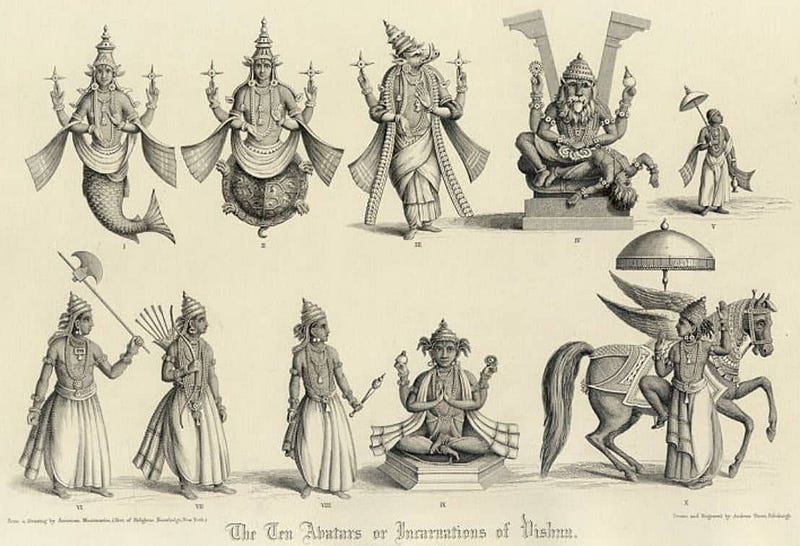Exploring the Dashavatars of Lord Vishnu and Evolutionary Theory
Written on
Chapter 1: The Origins of Life
Life on Earth began approximately 3.7 billion years ago. Today, we recognize around 8.7 million species. Prior to the 1800s, a significant intellectual debate revolved around the origins of life, largely dominated by the Creationism theory, which posited that a divine being created all life. However, this perspective shifted dramatically in 1859 when Charles Darwin introduced his groundbreaking work, "On the Origin of Species," proposing the theory of evolution through natural selection.
Many cultures have debated whether the concept of evolution was first articulated by Darwin or if it has its roots in ancient Hindu texts, as suggested by Indian sages. This discourse invites an examination of the parallels between the Dashavatars of Lord Vishnu and Darwin's evolutionary theory, considering whether the foundations of the latter are reflected in the Vedas or Puranas.
Lord Krishna, an avatar of Vishnu, proclaimed, "Whenever there has been a decimation of religion, I will incarnate in this world under a different guise." The Dashavatars, or ten incarnations of Lord Vishnu, initially include 24 avatars mentioned in the Shrimad Bhagavatam, but we will focus on the ten relevant to our discussion.
The first stage of evolution suggests that life originated in water during the Cambrian period, which aligns closely with the Matsya (fish) avatar of Lord Vishnu, representing aquatic life.

Chapter 2: Evolutionary Stages and Dashavatars
The second evolutionary stage indicates that life progressed to inhabit both water and land, aligning with the Kurma avatar, a tortoise that exemplifies amphibious characteristics.
The third stage marks the emergence of fully terrestrial animals, which connects to the Varaha avatar, the boar, a clear land dweller.
The fourth stage addresses the transition from apes to humans, represented by Narasimha, the half-man, half-animal avatar of Vishnu.
The fifth stage reflects the development of Homo sapiens, with the Vamana avatar, characterized as a short man, illustrating the diversity in human forms due to environmental factors.
The sixth evolutionary stage depicts the iron age, where humans became taller yet more aggressive, represented by Parshuram, an avatar wielding an axe.
In the seventh stage, humans evolved to form communities and improve their tools, paralleling the moral and righteous Shree Ram, another avatar of Vishnu.
The eighth stage signifies the dawn of advanced civilization, akin to Lord Krishna, who embodies self-awareness and moral consciousness, as explored in the Bhagavad Gita.
The ninth stage sees the emergence of self-realization and enlightenment in Homo sapiens, represented by the Buddha avatar of Vishnu.
Finally, the tenth stage, Homo spiritus, denotes a realization of divine nature and resurrection, anticipated through the Kalki avatar, who is prophesied to herald the end of evolution.
The first video, "Dashavatar & Darwin's Theory Of Evolution," explores how these two concepts intersect, providing insight into their similarities and differences.
While many draw parallels between the Dashavatars and Darwin's theory, it remains speculative. A deeper investigation reveals that Dashavatars are purposeful incarnations meant to address specific challenges, whereas Darwin's theory operates on a mechanistic view of nature, indifferent to human consciousness and intent.
The distinction is stark: the Dashavatars emerge from a rich tapestry of mythological narrative, while evolutionary theory is grounded in empirical observation and research. Although some may seek to draw connections, they may merely be attempting to align one framework with another. Darwin's upbringing and beliefs were far removed from Hindu philosophy, suggesting any perceived similarities are coincidental.
The second video, "Vishnu Avatars and the Theory of Evolution," further examines the relationship between these ancient texts and contemporary scientific thought.

If you have differing perspectives on this compelling analogy, feel free to share your thoughts.
Contributed by Rishab Karki and curated by the author. Thank you for reading! If you enjoyed this piece, please consider showing support by becoming a Medium member or buying me a coffee. Stay tuned for more engaging stories!